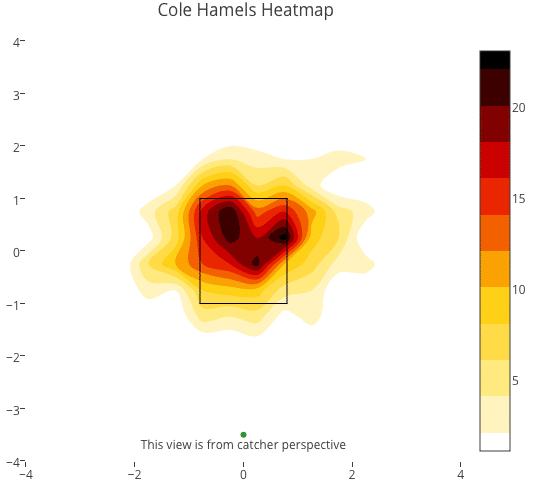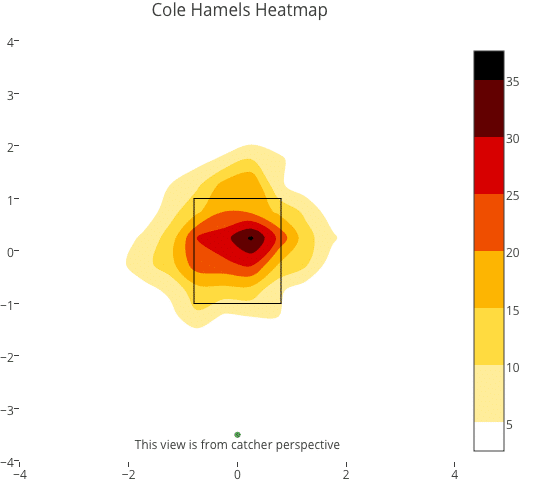
Cole Hamels Features Three Elite Secondary Pitches, But What About All the Homers?
Forget the 4.72 ERA and and 5.20 FIP for a moment, there are so many reasons to like this Cole Hamels deal. To understand exactly why I’m so bullish on this trade, let’s look at how the Cubs might be able to translate his pure stuff into run prevention.
When you think of Kyle Hendricks, what comes to mind? For me, it’s a changeup that looks essentially like a yo-yo. Well, the data suggests that Hamels’ offspeed pitch is just as good. And the new Cubs lefty has more than just a Hendricksian changeup in his repertoire.
Hamels throws five different pitches: Four-seam, sinker, curveball, changeup, and cutter/slider.
Anyone want to guess who leads MLB in whiff rate on the change this season (minimum 300 pitches)? That’s right, it’s ya boi, Hamels, who is generating an astounding 47 percent whiff/swing rate. Even crazier, Hamels’ changeup whiff rate is the best, well, ever (minimum 4,000 pitches). He literally has the best such mark since the data was tracked starting in 2007. That is absurd!
Hamels also has an impressive cutter/slider to complement his wicked changeup. Actually, “impressive” isn’t an adequate description, so we’ll turn to Joe Maddon’s pet superlative. Hamels’ cutter is “spectacular.” Its whiff/swing rate of 28 percent is third best in MLB (minimum 300 pitches). So not only does he have the best changeup whiff rate in MLB, he also showcases another secondary pitch that’s better than most other pitchers’ best secondary offering.
I could stop this post right there and still be satisfied that I’ve convinced you of the value Hamels brings to the Cubs, but I’ve got more more pitch to tell you about. The lefty’s curveball is also among the most elite in the game, generating a 40 percent whiff rate that is eighth best in MLB and third best for lefties.
Altogether, Hamels boasts three secondary pitches that are among the most elite in MLB by whiff rate. Why, then, are his ERA and FIP numbers orbiting around 5.00?
His primary issue has been the longball. Despite missing so many bats with the his secondaries this season, batters are still smashing 1.8 homers per nine innings against him. That’s no fluke of playing home games in a bandbox, as xStats believes 21 of his 23 homers surrendered would have left most ballparks. This homer bugaboo is a real thing.
As for what’s causing it, the answer is multifaceted but could be rooted in his fastball efficacy. Consider that Hamels’ four-seam, which he throws once every four pitches, has a .427 isolated power against. In other words, his fastball is getting clobbered time and time again this season.
In 2016 and 2017, over which Hamels surrendered a ~.140 ISO, he located the pitch much differently than during he has this season. Pay attention to the image below, in which his four-seam location is mostly up over the heart of the plate and toward the right portion of the strike zone.

But in 2016, the majority of his were on the left portion of the plate, many times outside the zone altogether.

And in 2017, Hamels’ four-seam shifted toward a defined portion of the right side of the zone.

Never before in recent seasons has Hamels ever thrown so many four-seams so high and over the middle of the plate. Why is he doing this? Is it intentional? Is it poor command? We don’t know. But maybe the Cubs have an idea after scouting and talking to their new pitcher.
If Hamels can adjust his four-seam profile to more closely resemble 2016 or ’17, perhaps the homers and extra-base hits decrease accordingly. And if he can keep the ball in the park more while maximizing his new top-tier defense and continuing to display those exceptional secondary pitches, it’s easy to imagine that ERA number dropping precipitously.
I don’t know about you, but I’m extremely excited to see how the Cubs utilize Hamels’ whiff-tastic basket of secondary pitches. Maybe all that needs to be addressed is four-seam utilization.
Note: Listen to me and fellow Cubs Insider Corey Freedman talk about Hamels on the most recent episode of the Cubs Related Podcast, to which you can subscribe on iTunes, Google Play, Stitcher, or TuneIn. And now we’re also on Spotify.

